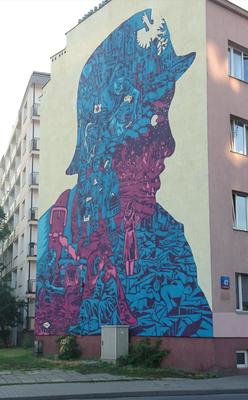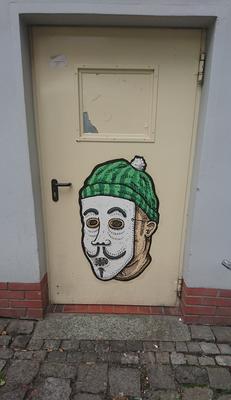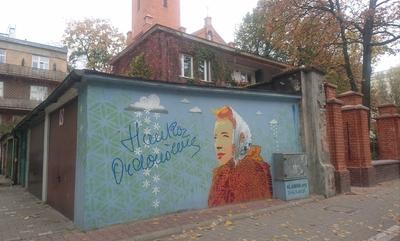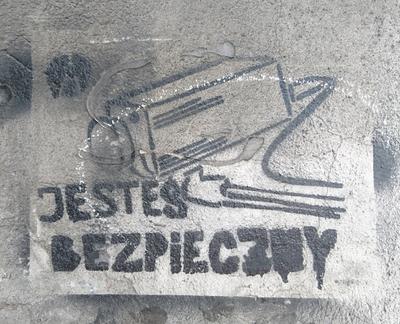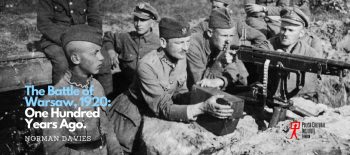Last summer, I spent a month living in Warsaw’s Muranów neighbourhood. One day I noticed a man on a ladder next to a concrete-grey garage wall, painting it light blue. As I walked past the garage across the next few days, I realised that he wasn’t just sprucing up a bland street-facing wall with a lick of paint – he was a street artist. Gradually, a few white clouds emerged against the blue sky background. And eventually, he painted the side profile of a woman wearing a brown coat with a fur trim and delicate headscarf.
After deciphering the name written next to the woman, I discovered that she was Hanka Ordonówna, a popular Polish cabaret singer and actor who was born and worked in Warsaw during the interwar years. After the Nazi invasion of Warsaw, she left for Vilnius, where she was eventually taken to Moscow by the Red Army and sent to a labour camp in Uzbekistan. Following the deportation of Poles from the USSR in 1942, she made her way to the Middle East, rescuing and caring for Polish children from Soviet orphanages. She died in Beirut in 1950 and is still well-loved in Poland today. Ordonówna is considered a patriot for her actions during the war – the street mural that I saw was designed to celebrate her life as a performance artist and social activist.
This particular mural was in a residential Warsaw side street, but Poland has its fair share of street art. Yes, there’s plenty of hastily scrawled tags and colourful dedications to football teams, but even this less artistic type of graffiti is occasionally turned into something quite poetic – football fans of the teams RTS Widzew and ŁKS in Łódź have a tradition of painting obscure, tongue-in-cheek insults on walls (two examples: “ŁKS joke about serious things”; “RTS eat bananas in their skins”). This style may be aesthetically ugly, but there’s still value in its ironic appraisal of the street/toilet/railway wall as a place to scribble profanity.
In its hurried, scaled-back approach, the style of graffiti favoured by Łódź football fans more closely resembles the original Polish street art of the 1980s, when – as a response to the repression of martial law – Polish artists primarily used stencil templates and written slogans to quickly decorate the streets with subversive imagery. A famous example of the street art of this era are the dwarves spray-painted by the absurdist, underground anti-communist Orange Alternative in Wrocław. It’s difficult to track down much remaining original Polish street art from the 80s, but the stencil inspiration remains strong today. On my travels, I’ve seen the Solidarity trade union logo regularly re-appropriated (most notably into the word ‘authority’), a pro-vegan stencil declaring that “your body is a grave of animals”, and a stencil of a CCTV camera suggesting “you are safe”.
Political street art doesn’t only belong to small-scale, blink-and-you’ll-miss stencil designs. The most impressive street art in Poland is usually painted in grand strokes across the formerly blank facades of tenement houses, or housing blocks from the 1970s. Two murals of this kind stick out for me. The first is in Warsaw’s Wola district. At first sight, it shows a soldier’s side profile, in a teal and magenta pattern. Upon closer inspection, it’s a solemn memorial to the human impact of war, detailing a rubbled wasteland, child refugees, and nurses attending to the injured. The second is in Radom, a town in central Poland, and is painted across two sides of a 10-storey block. One side depicts a worker, the other side shows a chain of linked hands – together they reference the nationwide street demonstrations and strikes against the cost of food in June 1976, the largest of which took place with 20,000 people in Radom.
There’s a long tradition of political street art in Poland, but many artists are equally interested in other types of expression. As in my first example of the Hanka Ordonówna mural, some artists create designs of well-known people connected to Poland. Poland is famous for its countless statues of Pope John Paul II – his image can also be found on many Polish walls, from large cities such as Szczecin to small towns like Jaworzno. On a trip to Kraków, it was a pleasant surprise for me to spot sci-fi author Stanisław Lem’s moon-shaped face above a large mural depicting the type of robot you might read about in his novels. If you like the David Bowie mural in Brixton, you should see the one in Żoliborz, painted after his death in a nod to the singer’s brief 1973 visit to Poland’s capital. It shows a young Bowie’s face, but with Warsaw’s iconic Palace of Culture and Science in place of the classic Ziggy Stardust stripe.
Although all of the above designs have clear artistic merit, other street artists focus solely on aesthetics. If you cross the Oder river from Wrocław’s Old Town to Nadodrze, you’ll be greeted by the so-called ‘Gate To Nadodrze’, a large mural showing this older district’s historic tenement houses below a futuristic portal. From my apartment in Warsaw Ochota, it’s a quick walk to the 30-metre-high surreal mural of a floating man with multiple hands and legs. In Eastern Poland, the city of Białystok has a spectacular whole wall painting of a girl in traditional Polish dress watering a (real-life) tree beneath, which, of course, is green with life in the summer.
Whether political, person-based or visually enticing, the streets of Polish towns and cities are teeming with art. Often, all it takes is a trip to a less touristy district or a stroll down a more residential side street to come across something wonderful. The mural of Hanka Ordonówna is a good example of the universal appeal of Polish street art. For the casual passer-by or tourist, it’s a bright piece of modern art that lightens up what is an otherwise grey housing estate. For aficionados of interwar music and cinema, it depicts a famous local performance artist from the time. And for those who know a little more about Polish history, it stands as a fitting dedication to a cultural and political figure from the country’s past. There’s something for everyone.
On The Road...Through Poland with Richard Greenhill: Reclaim the streets
A CEE NOTTS project which aims to preserve the living history of CEE communities, tracing their roots from post-WW2 migrations to the recent EU accession waves. Residents are invited to participate in various events, celebrating working-class narratives that have shaped the region's rich cultural tapestry.
28
02.2024
30
06.2024
Blogs, Events, History, News, Resources
Polish history podcast by Norman Davies.
17
08.2020
Blogs, History, History, News
2024 © Instytut Polski w Londynie | Wykonanie: sm32
STUDIO

